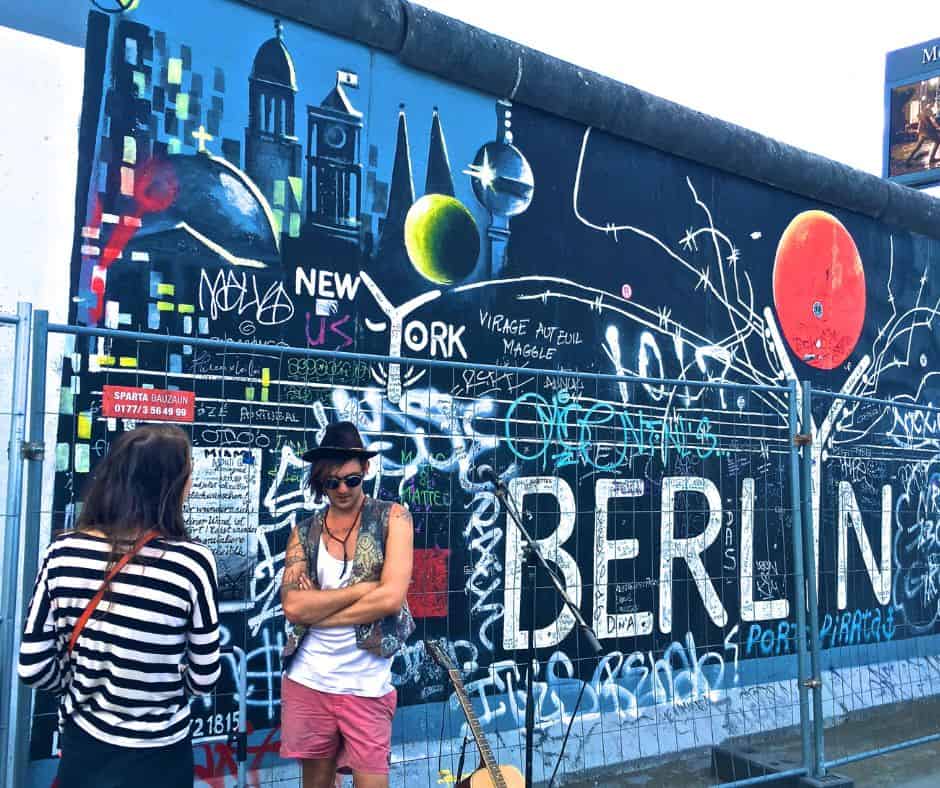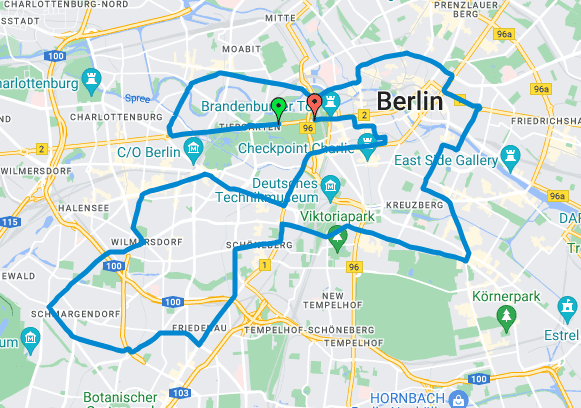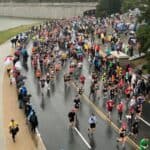The Berlin Marathon is one of the most prestigious running events in the world, with a rich history dating back over a century.
The Berlin Marathon Route is a challenging course known for its flat and fast course, making it popular among professional and amateur runners alike. The course takes you through historic towns and landmarks and offers breathtaking views along the way.
Whether you are a seasoned marathon runner or a beginner looking to take on a new challenge, this Berlin Marathon Route Guide is a must-have for any runner.
In this article, we will provide a detailed overview of the Berlin Marathon route, including:
- The Marathon Route Profile,
- Mile-by-mile breakdown of the course, and
- Hydration and Fuelling Stops Along the Berlin Marathon Route

Berlin Marathon Route Profile
The Berlin Marathon Route spans 26.2 miles (42.2 km) of excitement and determination, starting and finishing at one of the most iconic landmarks in Berlin – the Brandenburg Gate.
The first half of the Berlin Marathon route is relatively flat, taking runners through notable landmarks like the Brandenburg Gate, the Berliner Dom, the Reichstag, and Potsdamer Platz.
The second half introduces a few gentle climbs through quieter residential areas, including a “notable” climb at Prenzlauer Berg. I use the quotes here because while this is one of the climbs during the race, it is not going to dramatically affect your race, especially if you have trained well.
The final stretch requires endurance, returning to the city center with an uphill section called “The Wall” at the 39-kilometer mark. After this challenging part, the finish line at the Brandenburg Gate is in sight.
Seeing the Brandenburg Gate will help you forget about any “wall” and you will be energized by the crowds and the knowledge you are now embarking on finishing the Berlin Marathon!
The first few miles take you through the city center, past Berlin landmarks such as the Berliner Dom and the Reichstag building.
It’s essential to avoid getting caught up in the excitement of the starting crowds, reminding yourself to stick to your pace and strategy at the beginning of the race.
Once you’ve passed the 5km (3.11-mile) mark, you’ll enter the western part of the city and an area known as “Charlottenburg.” This is where you’ll find some of the inclines of the race, so it’s essential to be wary of your pace and save some energy during this section.
As you approach the 15km (9.32-mile) mark, you’ll also enter the “Berlin Wall” area of the race. This part of the route is an excellent chance to soak in some of Berlin’s history and take in the atmosphere around you.
Make a point of looking at the ground every now and then. The roads have been paved where the Berlin Wall once was and so it’s an amazing feeling when you’re running and you run over what once was a large border and full of history. Soak it in and remind yourself of the privilege of running a race like this, in a city steeped in so much history!
The halfway point of the race is marked by a turnaround after crossing over the iconic Oberbaumbrücke Bridge.
From there, you’ll head back towards the city center in the eastern part of Berlin, with the next few miles taking you past some of Berlin’s most famous and bustling neighborhoods.
The energy of the crowds in this part of the race can be a significant motivation boost, so remember to channel that energy and stick to your pace.
As you approach the final stretch of the race, you’ll pass through the famous Potsdamer Platz and enter the Tiergarten Park. This is typically where fatigue may begin to set in for runners, making it essential to muster your resilience and refine your endgame strategy for the last few miles.
With only a few kilometers left, you’ll run back to the city center, passing Brandenburg Gate once again before reaching the finish line.
Let’s have a detailed look at the course right from the start line…
Berlin Marathon Route Breakdown
Start Line:
The Berlin Marathon starts at Straße des 17. Juni, between Brandenburg Gate and the Victory Column. The elevation at this point is approximately 34 meters (111 feet) above sea level, providing a solid starting position for runners.
Do yourself a favor and try to get to the Victory Column in the days before your marathon (all while, of course, being cognizant of not staying on your feet for too long). It’s an amazing feeling standing in the Victory Tower, looking down the street you will be running on, and visualizing how you are going to feel on race day.
Miles 1-3:
This early section of the race is relatively flat, allowing participants to find their rhythm. Runners pass through the Victory Column.
The course then turns at ErnstReuterPlatz towards Tiergarten, one of the largest urban parks in Germany, providing runners with some much-needed greenery and space.
Miles 4-8:
As the runners approach the seventh mile of the Berlin Marathon, the course takes a slight detour to the southern banks of the Spree River, bringing them close to the iconic Reichstag, Germany’s esteemed government building. The sight of this historic landmark serves as a reminder of the city’s political significance.
Continuing, the athletes find themselves passing by the majestic Berlin Cathedral, also known as the Berliner Dom. This architectural gem stands as a testament to Berlin’s rich history and serves as a picturesque backdrop for the runners.
Moving forward, the course leads them through the bustling Alexanderplatz, a vibrant square that serves as one of the city’s largest transportation hubs.
Here, the runners will encounter the famous World Clock, a popular meeting point, and the imposing TV Tower (Fernsehturm), which offers panoramic views of the city. The Red City Hall (Rotes Rathaus), with its striking red-brick facade, also graces the surroundings, adding to the allure of this dynamic square.
Miles 9-14:
After the 15-km (9.3-mile) mark, runners reach the infamous Kottbusser Tor, famous for its nightlife, street bars, and lively atmosphere. They go towards the district of Kreuzberg, which has a reputation for celebrating multiculturalism, creativity, and street art.
The course has a slight incline during this section, providing runners with a challenge while also making it an enjoyable experience. Slow your pace if need be and enjoy the sights.

Miles 15-23:
After reaching the 25-km mark (approximately 15.5 miles), the Berlin Marathon course presents an interesting challenge for the runners.
For the next 500 meters, the route descends, offering a brief respite and a chance to regain momentum. However, this relief is short-lived as the course sharply inclines for the following 2 km (around 1.2 miles).
This ascent puts the athletes’ strength and determination to the test because you are also at the point of the marathon where many runners hit a “wall”
From this point on, the runners face a series of alternating short downhill and uphill sections for the next 10 kilometers (approximately 6.2 miles).
These undulating hills add a layer of complexity to the race, requiring the runners to constantly adapt their pace and effort.
Overall, despite the presence of these demanding sections, the marathon route gradually declines as the race progresses towards the final stretch. This gradual descent can provide a welcome relief for the participants, allowing them to push harder and maintain their pace in the closing stages of the race.
Miles 24-26.2: The final miles of the Berlin Marathon route are marked by a sense of triumph and determination. Runners enter the beautiful Tiergarten, a vast green oasis that provides a refreshing atmosphere.
As they approach the finish line, they make their way back to the iconic Brandenburg Gate, where the crowd’s cheers and the sight of the gate inspire a final surge of adrenaline.
Noteworthy landmarks just before the finish line include the green expanse of Tiergarten and the grand Straße des 17. Juni, leading the athletes back to the Brandenburg Gate, which serves as a magnificent backdrop for their ultimate accomplishment.

Berlin Marathon Course Map With Streets

Berlin Marathon Elevation Charts
By utilizing the Berlin Marathon elevation charts, you can create an effective race strategy that takes into account the specific paces you should maintain based on the elevation changes along the route. This will help you achieve your desired Berlin Marathon time goal.

Berlin Marathon Google Maps Link
When preparing for the race, make use of the map to zoom in and familiarise yourself with the roads you will be running on during the race.
Berlin Marathon Pacing Chart
Using a pacing chart in the Berlin Marathon offers significant benefits. It helps runners avoid the pitfalls of starting too fast, ensuring energy isn’t depleted prematurely.
By maintaining a consistent pace, runners can manage their endurance more effectively, preventing the dreaded “wall” later in the race. The mental advantage of breaking the race into manageable segments and the alignment of pacing with goals enhance motivation and goal achievement.
Additionally, using a chart enables strategic adjustments for variations in the course and boosts confidence as runners hit their pace targets.
Given the Berlin Marathon’s characteristics, including its flat course and potential for fast starts, a pacing chart can be a crucial asset for a successful and controlled performance.
Grab your Berlin Marathon Pacing Chart here within the next few days!
Hydration and Fuelling Stops Along the Berlin Marathon Route
Staying hydrated during the Berlin Marathon is essential to prevent dehydration and maintain performance.
Hydration stations are located along the route, offering water and sports drinks.
Let’s take a closer look at the refreshments and fueling options available along the Berlin Marathon course to help you plan your strategy effectively.
Please keep in mind that these offerings may vary from year to year depending on sponsors and race planning. Be sure to check the official documentation for the specific year you’re running to confirm the available options.
1. Refreshment Points:
- At kilometers 9, 15, 20, 25, 30, and 36, you’ll find refreshment points offering fruit, tea, and water.
- Water-only refreshment points are located at kilometers 5, 12, 17.5, 22.5, 27.5, 32.5, 34.5, 38, and 40.
2. Lichtenauer Mineralwasser:
- After passing kilometer 33, you’ll come across the Lichtenauer Cheeringpoint at Olivaer Platz.
- Upon completing the race, you’ll receive a 0.5-litre bottle of Lichtenauer Mineralwasser Pur in your finishing bag.
3. Maurten Fuel:
- Refreshment points at kilometres 9, 15, 20, 25, 27.5, 30, and 36 feature Maurten Fuel products.
- Maurten specializes in providing effective carbohydrate fueling solutions to enhance performance and minimize gastrointestinal issues.

4. Refreshments at the Finish:
- Marathon finishers will have access to refreshments and food.
- Refreshments include apples, bananas, salted pretzels, and chocolate rolls.
- Tea and water will be available at the refreshment stations.
5. ERDINGER Alkoholfrei:
- ERDINGER Alkoholfrei is a non-alcoholic thirst-quencher.
- It offers a lively, full-bodied refreshment with spicy malt notes and a slightly sweet taste.
- Brewed using natural ingredients in accordance with the Bavarian Purity Law.
- ERDINGER Alkoholfrei supports the regeneration process and is isotonic, containing vitamins B9 and B12.
- With only 25 kcal per 100 ml, it can be enjoyed guilt-free.
Remember, proper fueling and hydration are vital for a successful marathon. Utilize the aid stations strategically to replenish your energy and stay hydrated throughout the race.
Stop only for drinks and fuel, as you have planned in your training. NO TRYING NEW THINGS ON RACE DAY!
Related: The BEST Marathon Hydration Strategy According To Experts



Comments are closed.